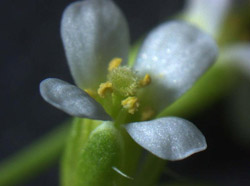Precise Molecular Surgery in the Plant Genome

Thale cress blossom: Common thale cress (Arabidopsis thaliana) is used as a model plant in many biotechnology experiments. (Photo: H. Puchta/ KIT)<br>
Crop plants have always been adapted to the needs of man by breeding for them to carry more fruit, survive droughts, or resist pests. Green biotechnology now adds new tools to the classical breeding methods for a more rapid and efficient improvement of plant properties.
A biotechnological technique developed by KIT botanists to more precisely and reliably install or modify genetic information in the plant genome is now presented by the expert journal PNAS. (DOI: 10.1073/pnas.1202191109).
The new method is based on the natural repair mechanism of plants. So-called homologous recombination repairs the genome when the genome strands in the cell break. “Using an appropriate enzyme, i.e. molecular scissors, we first make a cut at the right point in the genome and then supply the necessary patch to repair this cut,” says Friedrich Fauser from Karlsruhe Institute of Technology, who is the first author of the PNAS publication. “A part of this patch is the new gene piece we want to install. The rest is done by the repair service of the cell.”
Due to this trick, the method that is referred to as “in planta gene targeting” (IPGT) is highly reliable and the new genetic information is incorporated in the genome precisely at the point desired. In principle, IPGT may be applied to every plant. “This is a big advantage compared to conventional methods that work for certain plants only and produce a lot of rejects,” explains Professor Holger Puchta, who holds the Chair for Molecular Biology and Biochemistry of Plants at Karlsruhe Institute of Technology. “Thanks to appropriate molecular scissors and patches and the natural repair mechanism of the cell, IPGT is about 100 times more efficient than techniques used so far.”
With their experiments on the model plant of thale cress (Arabidopsis thaliana), the researchers of KIT, in cooperation with the company SunGene GmbH, a subsidiary of BASF Plant Science having its office at Gatersleben, have now succeeded in furnishing evidence of the fact that IPGT works in plants. “The next step towards broader application in biotechnolgoy will be the transfer of the principle to other plants and the development of appropriate scissors and patches,” says Puchta. In this way, the favorable properties of wild species can be transferred rapidly to crop plants. The long-term objective is the optimum use of natural resources for the production of food and vegetable raw materials.
The paper in the portal of the journal PNAS:
http://www.pnas.org/
The homepage of the working group of Professor Puchta.
http://www.botanik2.uni-karlsruhe.de/591.php
Karlsruhe Institute of Technology (KIT) is a public corporation according to the legislation of the state of Baden-Württemberg. It fulfills the mission of a university and the mission of a national research center of the Helmholtz Association. KIT focuses on a knowledge triangle that links the tasks of research, teaching, and innovation.
For further information, please contact:
Margarete Lehné
Presse, Kommunikation und Marketing
Phone: +49 721 608-48121
Fax: +49 721 608-45681
margarete lehne∂kit edu
Media Contact
More Information:
http://www.kit.eduAll latest news from the category: Life Sciences and Chemistry
Articles and reports from the Life Sciences and chemistry area deal with applied and basic research into modern biology, chemistry and human medicine.
Valuable information can be found on a range of life sciences fields including bacteriology, biochemistry, bionics, bioinformatics, biophysics, biotechnology, genetics, geobotany, human biology, marine biology, microbiology, molecular biology, cellular biology, zoology, bioinorganic chemistry, microchemistry and environmental chemistry.
Newest articles

Innovative 3D printed scaffolds offer new hope for bone healing
Researchers at the Institute for Bioengineering of Catalonia have developed novel 3D printed PLA-CaP scaffolds that promote blood vessel formation, ensuring better healing and regeneration of bone tissue. Bone is…

The surprising role of gut infection in Alzheimer’s disease
ASU- and Banner Alzheimer’s Institute-led study implicates link between a common virus and the disease, which travels from the gut to the brain and may be a target for antiviral…

Molecular gardening: New enzymes discovered for protein modification pruning
How deubiquitinases USP53 and USP54 cleave long polyubiquitin chains and how the former is linked to liver disease in children. Deubiquitinases (DUBs) are enzymes used by cells to trim protein…



